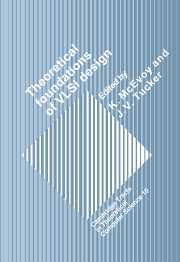Book contents
- Frontmatter
- Contents
- List of contributors
- Preface
- Introduction
- Part 1 Formal methods and verification
- Part 2 Theory and methodology of design
- 5 Formal specification of a digital correlator
- 6 Describing and reasoning about circuits using relations
- 7 The synthesis of VLSI signal processors: theory and example
- Part 3 Methods of circuits and complexity theory
7 - The synthesis of VLSI signal processors: theory and example
Published online by Cambridge University Press: 06 November 2009
- Frontmatter
- Contents
- List of contributors
- Preface
- Introduction
- Part 1 Formal methods and verification
- Part 2 Theory and methodology of design
- 5 Formal specification of a digital correlator
- 6 Describing and reasoning about circuits using relations
- 7 The synthesis of VLSI signal processors: theory and example
- Part 3 Methods of circuits and complexity theory
Summary
ABSTRACT
The theme of this chapter centres on the automatic synthesis of cost effective and highly parallel digital signal processors suitable for VLSI implementation. The proposed synthesis model is studied in detail and the concepts of signal modelling and data flow analysis are discussed. This is further illustrated by the COSPRO (COnfigurable Signal PROcessor) simulator – a primitive version of the automatic synthesis concept developed at the Department of Electrical & Electronic Engineering, University of Newcastle Upon Tyne. Binary addition is chosen as a case study to demonstrate the application of the concept.
INTRODUCTION
Digital signal processing
Digital signal processing (DSP), a counterpart of analog signal processing, began to blossom in the mid 1960s when semiconductor and computer technologies were able to offer a massive increase in flexibility and reliability. Within the short period of twenty years, this field has matured rapidly in both theory and applications, and contributed significantly to the understanding in many diverse areas of science and technology. The range of applications has grown to include almost every part of our lives, from microprocessor controlled domestic appliances to computerised banking systems and highly sophisticated missile guidance systems. Many other areas such as biomedical engineering, seismic research, radar and sonar detection and countermeasures, acoustics and speech, telecommunications, image processing and understanding, thermography, office automation and computer graphics employ DSP to a great extent, and are heavily applied in military, intelligence, industrial and commercial environments.
- Type
- Chapter
- Information
- Theoretical Foundations of VLSI Design , pp. 299 - 344Publisher: Cambridge University PressPrint publication year: 1990

